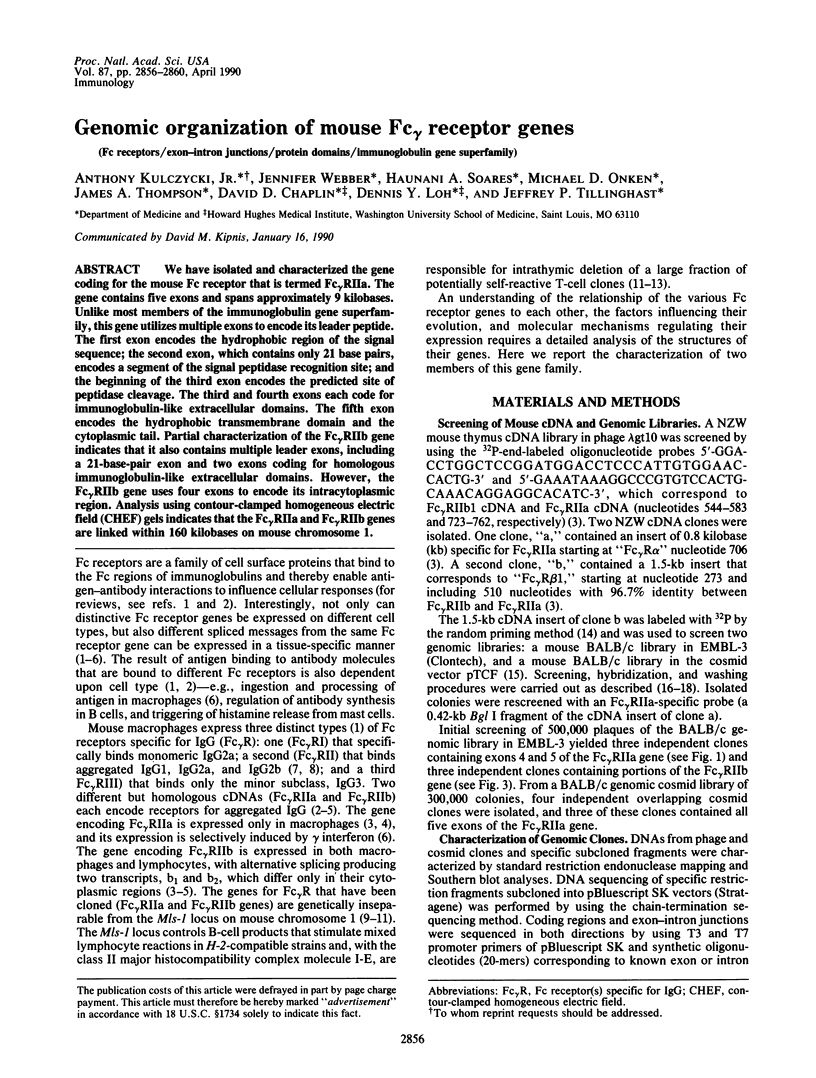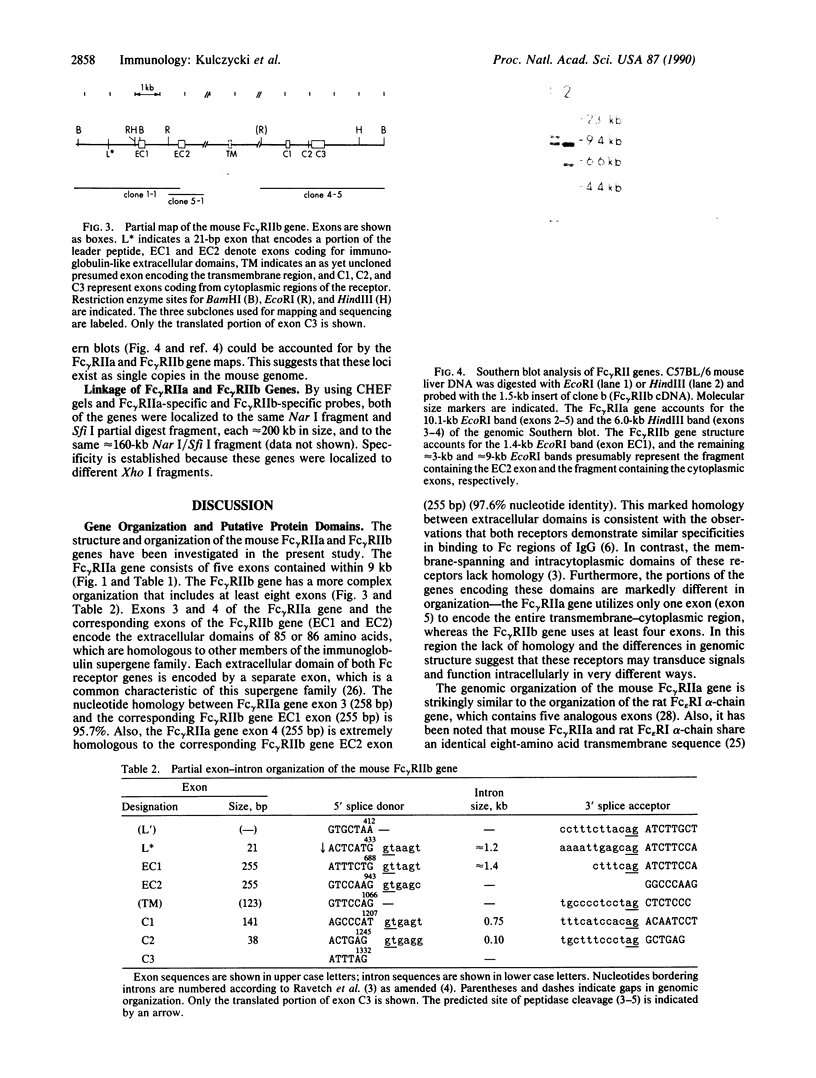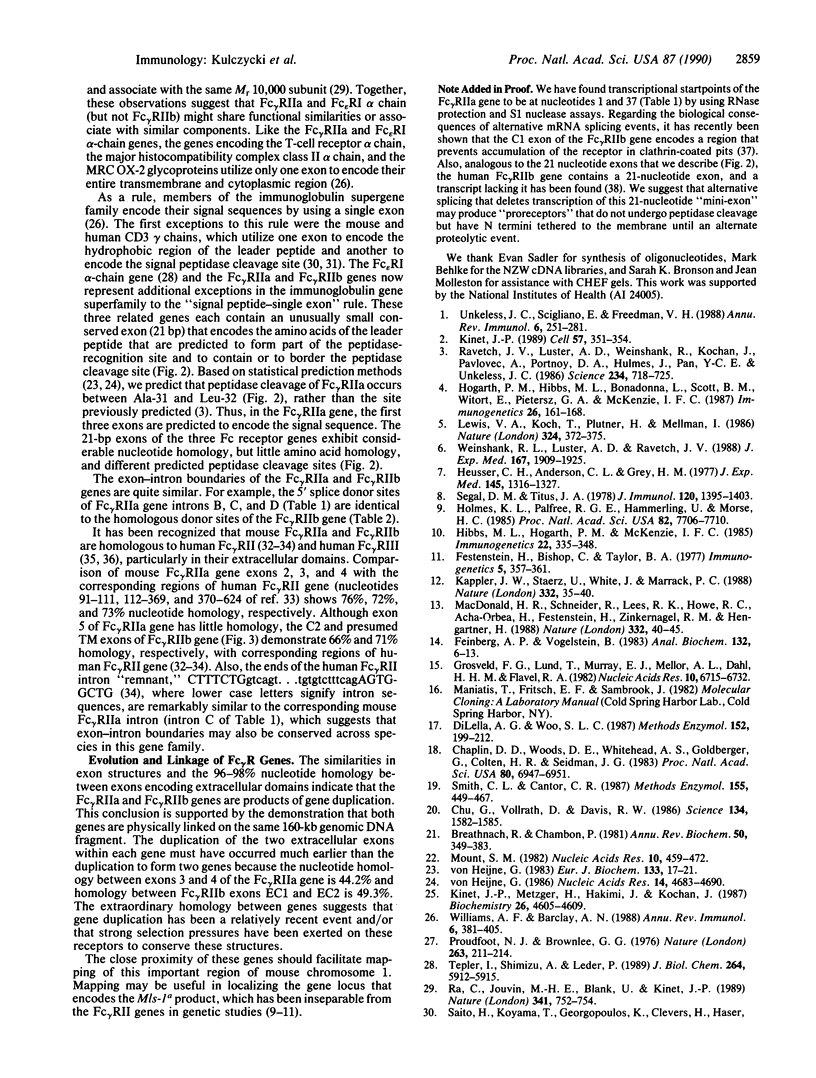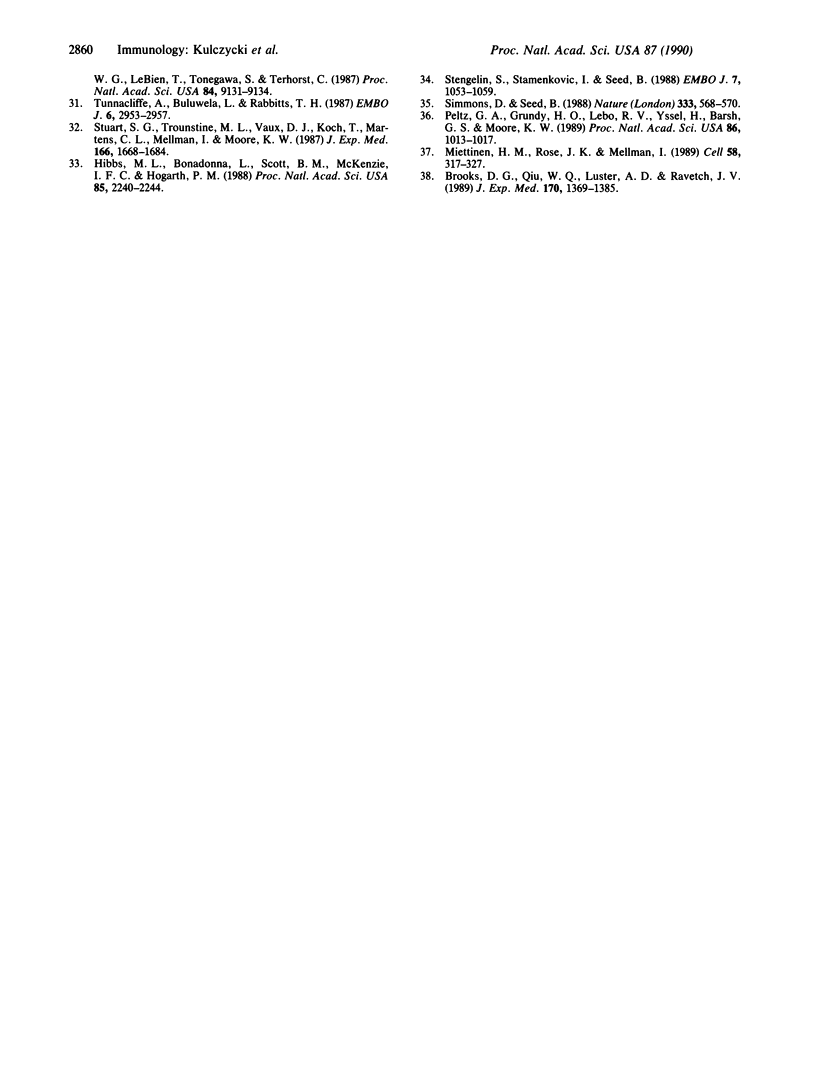Abstract
We have isolated and characterized the gene coding for the mouse Fc receptor that is termed Fc gamma RIIa. The gene contains five exons and spans approximately 9 kilobases. Unlike most members of the immunoglobulin gene superfamily, this gene utilizes multiple exons to encode its leader peptide. The first exon encodes the hydrophobic region of the signal sequence; the second exon, which contains only 21 base pairs, encodes a segment of the signal peptidase recognition site; and the beginning of the third exon encodes the predicted site of peptidase cleavage. The third and fourth exons each code for immunoglobulin-like extracellular domains. The fifth exon encodes the hydrophobic transmembrane domain and the cytoplasmic tail. Partial characterization of the Fc gamma RIIb gene indicates that it also contains multiple leader exons, including a 21-base-pair exon and two exons coding for homologous immunoglobulin-like extracellular domains. However, the Fc gamma RIIb gene uses four exons to encode its intracytoplasmic region. Analysis using contour-clamped homogeneous electric field (CHEF) gels indicates that the Fc gamma RIIa and Fc gamma RIIb genes are linked within 160 kilobases on mouse chromosome 1.
Full text
PDF




Images in this article
Selected References
These references are in PubMed. This may not be the complete list of references from this article.
- Breathnach R., Chambon P. Organization and expression of eucaryotic split genes coding for proteins. Annu Rev Biochem. 1981;50:349–383. doi: 10.1146/annurev.bi.50.070181.002025. [DOI] [PubMed] [Google Scholar]
- Brooks D. G., Qiu W. Q., Luster A. D., Ravetch J. V. Structure and expression of human IgG FcRII(CD32). Functional heterogeneity is encoded by the alternatively spliced products of multiple genes. J Exp Med. 1989 Oct 1;170(4):1369–1385. doi: 10.1084/jem.170.4.1369. [DOI] [PMC free article] [PubMed] [Google Scholar]
- Chaplin D. D., Woods D. E., Whitehead A. S., Goldberger G., Colten H. R., Seidman J. G. Molecular map of the murine S region. Proc Natl Acad Sci U S A. 1983 Nov;80(22):6947–6951. doi: 10.1073/pnas.80.22.6947. [DOI] [PMC free article] [PubMed] [Google Scholar]
- Chu G., Vollrath D., Davis R. W. Separation of large DNA molecules by contour-clamped homogeneous electric fields. Science. 1986 Dec 19;234(4783):1582–1585. doi: 10.1126/science.3538420. [DOI] [PubMed] [Google Scholar]
- DiLella A. G., Woo S. L. Cloning large segments of genomic DNA using cosmid vectors. Methods Enzymol. 1987;152:199–212. doi: 10.1016/0076-6879(87)52021-3. [DOI] [PubMed] [Google Scholar]
- Feinberg A. P., Vogelstein B. A technique for radiolabeling DNA restriction endonuclease fragments to high specific activity. Anal Biochem. 1983 Jul 1;132(1):6–13. doi: 10.1016/0003-2697(83)90418-9. [DOI] [PubMed] [Google Scholar]
- Grosveld F. G., Lund T., Murray E. J., Mellor A. L., Dahl H. H., Flavell R. A. The construction of cosmid libraries which can be used to transform eukaryotic cells. Nucleic Acids Res. 1982 Nov 11;10(21):6715–6732. doi: 10.1093/nar/10.21.6715. [DOI] [PMC free article] [PubMed] [Google Scholar]
- Heusser C. H., Anderson C. L., Grey H. M. Receptors for IgG: subclass specificity of receptors on different mouse cell types and the definition of two distinct receptors on a macrophage cell line. J Exp Med. 1977 May 1;145(5):1316–1327. doi: 10.1084/jem.145.5.1316. [DOI] [PMC free article] [PubMed] [Google Scholar]
- Hibbs M. L., Bonadonna L., Scott B. M., McKenzie I. F., Hogarth P. M. Molecular cloning of a human immunoglobulin G Fc receptor. Proc Natl Acad Sci U S A. 1988 Apr;85(7):2240–2244. doi: 10.1073/pnas.85.7.2240. [DOI] [PMC free article] [PubMed] [Google Scholar]
- Hibbs M. L., Hogarth P. M., McKenzie I. F. The mouse Ly-17 locus identifies a polymorphism of the Fc receptor. Immunogenetics. 1985;22(4):335–348. doi: 10.1007/BF00430917. [DOI] [PubMed] [Google Scholar]
- Hogarth P. M., Hibbs M. L., Bonadonna L., Scott B. M., Witort E., Pietersz G. A., McKenzie I. F. The mouse Fc receptor for IgG (Ly-17): molecular cloning and specificity. Immunogenetics. 1987;26(3):161–168. doi: 10.1007/BF00365906. [DOI] [PubMed] [Google Scholar]
- Holmes K. L., Palfree R. G., Hammerling U., Morse H. C., 3rd Alleles of the Ly-17 alloantigen define polymorphisms of the murine IgG Fc receptor. Proc Natl Acad Sci U S A. 1985 Nov;82(22):7706–7710. doi: 10.1073/pnas.82.22.7706. [DOI] [PMC free article] [PubMed] [Google Scholar]
- Kappler J. W., Staerz U., White J., Marrack P. C. Self-tolerance eliminates T cells specific for Mls-modified products of the major histocompatibility complex. Nature. 1988 Mar 3;332(6159):35–40. doi: 10.1038/332035a0. [DOI] [PubMed] [Google Scholar]
- Kinet J. P. Antibody-cell interactions: Fc receptors. Cell. 1989 May 5;57(3):351–354. doi: 10.1016/0092-8674(89)90910-0. [DOI] [PubMed] [Google Scholar]
- Kinet J. P., Metzger H., Hakimi J., Kochan J. A cDNA presumptively coding for the alpha subunit of the receptor with high affinity for immunoglobulin E. Biochemistry. 1987 Jul 28;26(15):4605–4610. doi: 10.1021/bi00389a002. [DOI] [PubMed] [Google Scholar]
- Lewis V. A., Koch T., Plutner H., Mellman I. A complementary DNA clone for a macrophage-lymphocyte Fc receptor. 1986 Nov 27-Dec 3Nature. 324(6095):372–375. doi: 10.1038/324372a0. [DOI] [PubMed] [Google Scholar]
- MacDonald H. R., Schneider R., Lees R. K., Howe R. C., Acha-Orbea H., Festenstein H., Zinkernagel R. M., Hengartner H. T-cell receptor V beta use predicts reactivity and tolerance to Mlsa-encoded antigens. Nature. 1988 Mar 3;332(6159):40–45. doi: 10.1038/332040a0. [DOI] [PubMed] [Google Scholar]
- Miettinen H. M., Rose J. K., Mellman I. Fc receptor isoforms exhibit distinct abilities for coated pit localization as a result of cytoplasmic domain heterogeneity. Cell. 1989 Jul 28;58(2):317–327. doi: 10.1016/0092-8674(89)90846-5. [DOI] [PubMed] [Google Scholar]
- Mount S. M. A catalogue of splice junction sequences. Nucleic Acids Res. 1982 Jan 22;10(2):459–472. doi: 10.1093/nar/10.2.459. [DOI] [PMC free article] [PubMed] [Google Scholar]
- Peltz G. A., Grundy H. O., Lebo R. V., Yssel H., Barsh G. S., Moore K. W. Human Fc gamma RIII: cloning, expression, and identification of the chromosomal locus of two Fc receptors for IgG. Proc Natl Acad Sci U S A. 1989 Feb;86(3):1013–1017. doi: 10.1073/pnas.86.3.1013. [DOI] [PMC free article] [PubMed] [Google Scholar]
- Proudfoot N. J., Brownlee G. G. 3' non-coding region sequences in eukaryotic messenger RNA. Nature. 1976 Sep 16;263(5574):211–214. doi: 10.1038/263211a0. [DOI] [PubMed] [Google Scholar]
- Ra C., Jouvin M. H., Blank U., Kinet J. P. A macrophage Fc gamma receptor and the mast cell receptor for IgE share an identical subunit. Nature. 1989 Oct 26;341(6244):752–754. doi: 10.1038/341752a0. [DOI] [PubMed] [Google Scholar]
- Ravetch J. V., Luster A. D., Weinshank R., Kochan J., Pavlovec A., Portnoy D. A., Hulmes J., Pan Y. C., Unkeless J. C. Structural heterogeneity and functional domains of murine immunoglobulin G Fc receptors. Science. 1986 Nov 7;234(4777):718–725. doi: 10.1126/science.2946078. [DOI] [PubMed] [Google Scholar]
- Saito H., Koyama T., Georgopoulos K., Clevers H., Haser W. G., LeBien T., Tonegawa S., Terhorst C. Close linkage of the mouse and human CD3 gamma- and delta-chain genes suggests that their transcription is controlled by common regulatory elements. Proc Natl Acad Sci U S A. 1987 Dec;84(24):9131–9134. doi: 10.1073/pnas.84.24.9131. [DOI] [PMC free article] [PubMed] [Google Scholar]
- Segal D. M., Titus J. A. The subclass specificity for the binding of murine myeloma proteins to macrophage and lymphocyte cell lines and to normal spleen cells. J Immunol. 1978 Apr;120(4):1395–1403. [PubMed] [Google Scholar]
- Simmons D., Seed B. The Fc gamma receptor of natural killer cells is a phospholipid-linked membrane protein. Nature. 1988 Jun 9;333(6173):568–570. doi: 10.1038/333568a0. [DOI] [PubMed] [Google Scholar]
- Smith C. L., Cantor C. R. Purification, specific fragmentation, and separation of large DNA molecules. Methods Enzymol. 1987;155:449–467. doi: 10.1016/0076-6879(87)55030-3. [DOI] [PubMed] [Google Scholar]
- Stengelin S., Stamenkovic I., Seed B. Isolation of cDNAs for two distinct human Fc receptors by ligand affinity cloning. EMBO J. 1988 Apr;7(4):1053–1059. doi: 10.1002/j.1460-2075.1988.tb02913.x. [DOI] [PMC free article] [PubMed] [Google Scholar]
- Stuart S. G., Trounstine M. L., Vaux D. J., Koch T., Martens C. L., Mellman I., Moore K. W. Isolation and expression of cDNA clones encoding a human receptor for IgG (Fc gamma RII). J Exp Med. 1987 Dec 1;166(6):1668–1684. doi: 10.1084/jem.166.6.1668. [DOI] [PMC free article] [PubMed] [Google Scholar]
- Tepler I., Shimizu A., Leder P. The gene for the rat mast cell high affinity IgE receptor alpha chain. Structure and alternative mRNA splicing patterns. J Biol Chem. 1989 Apr 5;264(10):5912–5915. [PubMed] [Google Scholar]
- Tunnacliffe A., Buluwela L., Rabbitts T. H. Physical linkage of three CD3 genes on human chromosome 11. EMBO J. 1987 Oct;6(10):2953–2957. doi: 10.1002/j.1460-2075.1987.tb02600.x. [DOI] [PMC free article] [PubMed] [Google Scholar]
- Unkeless J. C., Scigliano E., Freedman V. H. Structure and function of human and murine receptors for IgG. Annu Rev Immunol. 1988;6:251–281. doi: 10.1146/annurev.iy.06.040188.001343. [DOI] [PubMed] [Google Scholar]
- Weinshank R. L., Luster A. D., Ravetch J. V. Function and regulation of a murine macrophage-specific IgG Fc receptor, Fc gamma R-alpha. J Exp Med. 1988 Jun 1;167(6):1909–1925. doi: 10.1084/jem.167.6.1909. [DOI] [PMC free article] [PubMed] [Google Scholar]
- Williams A. F., Barclay A. N. The immunoglobulin superfamily--domains for cell surface recognition. Annu Rev Immunol. 1988;6:381–405. doi: 10.1146/annurev.iy.06.040188.002121. [DOI] [PubMed] [Google Scholar]
- von Heijne G. A new method for predicting signal sequence cleavage sites. Nucleic Acids Res. 1986 Jun 11;14(11):4683–4690. doi: 10.1093/nar/14.11.4683. [DOI] [PMC free article] [PubMed] [Google Scholar]
- von Heijne G. Patterns of amino acids near signal-sequence cleavage sites. Eur J Biochem. 1983 Jun 1;133(1):17–21. doi: 10.1111/j.1432-1033.1983.tb07424.x. [DOI] [PubMed] [Google Scholar]



